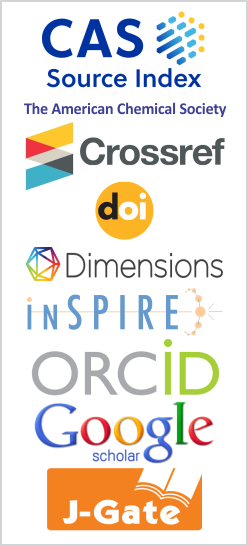Bremsstrahlung of Fast Electrons Near Fano Resonance with Account for Polarization Channel
DOI:
https://doi.org/10.26713/jamcnp.v4i1-3.769Keywords:
Bremsstrahlung, Polarization Bremsstrahlung, Helium atom, Fano resonanceAbstract
We investigate the Bremsstrahlung originating from fast non-relativistic electron scattering on an atom in the spectral region near the Fano resonance including the polarization channel and interference term. It is shown that the account for polarization Bremsstrahlung leads to a significant increase of the total Bremstrahlung cross section near the Fano resonances. Numerical calculations are carried out for the first autoionization states 2l2l' of the Helium atom in the framework of the Born approximation that goes beyond the dipole approximation of the dynamic polarizability of the atom.Downloads
References
V.N. Tsytovich and I.M. Oiringel (eds.), Polarization Bremsstrahlung, Springer (1992).
V. Astapenko, Polarization Bremsstrahlung on Atoms, Plasmas, Nanoscructures and Solids, Springer (2013).
A.V. Korol and A.V. Solov'yov, Polarization Bremsstrahlung, Springer (2014).
F.B. Rosmej, V.A. Astapenko and V.S. Lisitsa, XUV and x-ray elastic scattering of attosecond electromagnetic pulses on atoms, J. Phys. B 50, 235601 (2017).
U. Fano, Effects of configuration interaction on intensities and phase shifts, Phys. Rev. 124, 1866 (1961).
V.A. Astapenko and E.S. Khramov, Scattering of ultrashort electromagnetic pulses on fano resonance, International Review of Atomic and Molecular Physics 7 (2), 53 (2016).
J.A.R. Samson and W.C. Stolte, Precision measurements of the total photoionization cross-sections of He, Ne, Ar, Kr, and Xe, Journal of Electron Spectroscopy and Related Phenomena 123, 265 (2002).
Downloads
Published
How to Cite
Issue
Section
License
Authors who publish with this journal agree to the following terms:- Authors retain copyright and grant the journal right of first publication with the work simultaneously licensed under a CCAL that allows others to share the work with an acknowledgement of the work's authorship and initial publication in this journal.
- Authors are able to enter into separate, additional contractual arrangements for the non-exclusive distribution of the journal's published version of the work (e.g., post it to an institutional repository or publish it in a book), with an acknowledgement of its initial publication in this journal.
- Authors are permitted and encouraged to post their work online (e.g., in institutional repositories or on their website) prior to and during the submission process, as it can lead to productive exchanges, as well as earlier and greater citation of published work.




